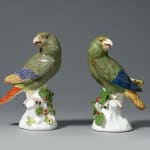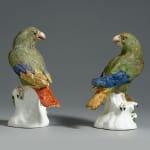

Important Pair of Early Meissen models of South American Parrots, modelled by Johann Joachim Käendler, Circa: 1738 – 1742
An Important Pair of Early Meissen models of South American Parrots, modelled by Johann Joachim Käendler each perched upon a white tree stump and looking to one side, beautifully naturalistically coloured, each representing a Green Amazon Parrot painted in green with puce detailing to its plumage, and with red, blue and yellow wing tips and tail, the tree stumps issuing leafy berried branches.
Marks
Traces of Blue crossed swords marks in underglaze blue to the underside of the base, one with pressnummer 45.
These colourful and flamboyant models take their place within the production at Meissen for a number of social and historical reasons. During the first half of the eighteenth century, there was an interest indeed a craze, of all things exotic. There was a fusion of the Chinese influence and keenness to surround oneself with the trappings of the orient reproduced in the ultimate new and prized European porcelain. A sense of discovery is noted within these models as the New World, South America is brought to mind in the colouring of these specific models. However, they are also very close to the “Rose head” parrots of Guinea, birds which were brought back by the Trading Companies who sailed East and then sold to the European aristocracy, strong in their vogue for keeping these birds in their menageries.
Helmut Borsch-Supan writes in ‘Die Chinamode in der Malerie des 17 und 18 Jahrhunderts’, “In animal sculpture of the 17th and 18th Centuries a generally exotic character was popular which in painting recalls paradise. The tiger, elephant, monkey and parrot often turn up in chinoiserie” (i). The courtiers were also fascinated in the subtle natures of the parrot, for example, its close affinity and loyal nature that could develop between it and its master, particularly in its ability to mimic the human tongue. This tropical descent led to them being regarded as messengers from paradise and no wonder that therefore Käendler immortalised them in porcelain.
For similar examples see Rainer Rückert “Meissener Porzellan 1710 – 1810” p. 266, nos. 1083 and 1084, also Yvonne Hackenbroch “Meissen and other continental Porcelain in the Irwin Untermyer Collection”, fig. 10, pl.5, now in the Metropolitan Museum, New York, a pair illustrated Berlin, Staatliche Museen: “Verzeichnis der Neuermerbungen” seit 1933 p. 161, nos. 117 & 119, also examples illustrated in Carl Albiker “Die Meissner Porzellantiere im 18 Jahrunderts”, pl. 26, no. 96. A collection of Meissen parrots formed by the Baron Erich von Goldschmidt – Rothschild sold at Christies Geneva 9 May 1988.
(i) the article written by Ulrich Pietsch “Porcelain in Dresden” Antiques Magazine, January 2003.
Join our mailing list
* denotes required fields
We will process the personal data you have supplied in accordance with our privacy policy (available on request). You can unsubscribe or change your preferences at any time by clicking the link in our emails.

